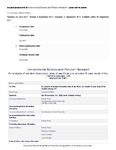An analysis of variable dissolution rates of sacrificial zinc anodes: a case study of the Hamble estuary, UK
| dc.contributor.author | Rees, AB | |
| dc.contributor.author | Gallagher, A | |
| dc.contributor.author | Comber, Sean | |
| dc.contributor.author | Wright, LA | |
| dc.date.accessioned | 2017-10-06T13:50:02Z | |
| dc.date.issued | 2017-09 | |
| dc.identifier.issn | 0944-1344 | |
| dc.identifier.issn | 1614-7499 | |
| dc.identifier.uri | http://hdl.handle.net/10026.1/10025 | |
| dc.description.abstract |
Sacrificial anodes are intrinsic to the protection of boats and marine structures by preventing the corrosion of metals higher up the galvanic scale through their preferential breakdown. The dissolution of anodes directly inputs component metals into local receiving waters, with variable rates of dissolution evident in coastal and estuarine environments. With recent changes to the Environmental Quality Standard (EQS), the load for zinc in estuaries such as the Hamble, UK, which has a large amount of recreational craft, now exceeds the zinc standard of 7.9 μg/l. A survey of boat owners determined corrosion rates and estimated zinc loading at between 6.95 and 7.11 t/year. The research confirms the variable anode corrosion within the Hamble and highlighted a lack of awareness of anode technology among boat owners. Monitoring and investigation discounted metal structures and subterranean power cables as being responsible for these variations but instead linked accelerated dissolution to marina power supplies and estuarine salinity variations. | |
| dc.format.extent | 21422-21433 | |
| dc.format.medium | Print-Electronic | |
| dc.language | en | |
| dc.language.iso | en | |
| dc.publisher | Springer Science and Business Media LLC | |
| dc.subject | Boats | |
| dc.subject | EQS | |
| dc.subject | Estuary | |
| dc.subject | Hamble | |
| dc.subject | Sacrificial anode | |
| dc.subject | Zinc | |
| dc.subject | Corrosion | |
| dc.subject | Electrodes | |
| dc.subject | Environmental Monitoring | |
| dc.subject | Estuaries | |
| dc.subject | Salinity | |
| dc.subject | Ships | |
| dc.subject | Solubility | |
| dc.subject | United Kingdom | |
| dc.subject | Water Pollutants, Chemical | |
| dc.subject | Zinc | |
| dc.title | An analysis of variable dissolution rates of sacrificial zinc anodes: a case study of the Hamble estuary, UK | |
| dc.type | journal-article | |
| dc.type | Journal Article | |
| plymouth.author-url | https://www.ncbi.nlm.nih.gov/pubmed/28744681 | |
| plymouth.issue | 26 | |
| plymouth.volume | 24 | |
| plymouth.publication-status | Published | |
| plymouth.journal | Environmental Science and Pollution Research | |
| dc.identifier.doi | 10.1007/s11356-017-9762-2 | |
| plymouth.organisational-group | /Plymouth | |
| plymouth.organisational-group | /Plymouth/Faculty of Science and Engineering | |
| plymouth.organisational-group | /Plymouth/Faculty of Science and Engineering/School of Geography, Earth and Environmental Sciences | |
| plymouth.organisational-group | /Plymouth/REF 2021 Researchers by UoA | |
| plymouth.organisational-group | /Plymouth/REF 2021 Researchers by UoA/UoA06 Agriculture, Veterinary and Food Science | |
| plymouth.organisational-group | /Plymouth/Research Groups | |
| plymouth.organisational-group | /Plymouth/Research Groups/BEACh | |
| plymouth.organisational-group | /Plymouth/Research Groups/Marine Institute | |
| plymouth.organisational-group | /Plymouth/Users by role | |
| plymouth.organisational-group | /Plymouth/Users by role/Academics | |
| dc.publisher.place | Germany | |
| dcterms.dateAccepted | 2017-07-11 | |
| dc.rights.embargodate | 2018-7-25 | |
| dc.identifier.eissn | 1614-7499 | |
| dc.rights.embargoperiod | Not known | |
| rioxxterms.versionofrecord | 10.1007/s11356-017-9762-2 | |
| rioxxterms.licenseref.uri | http://www.rioxx.net/licenses/all-rights-reserved | |
| rioxxterms.licenseref.startdate | 2017-09 | |
| rioxxterms.type | Journal Article/Review |


